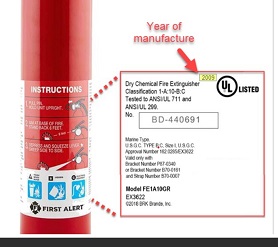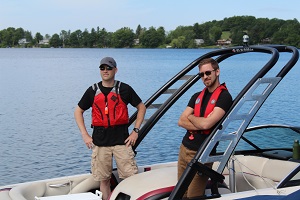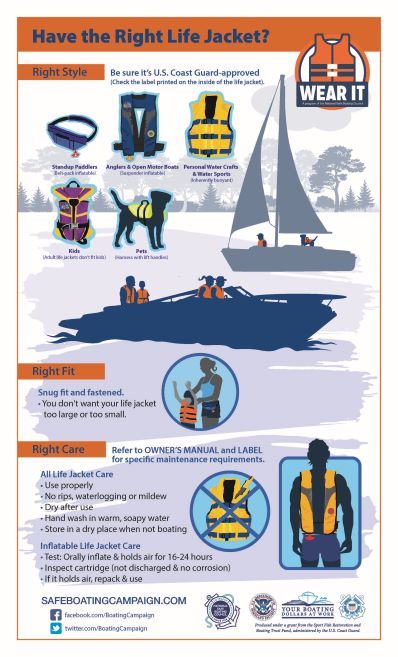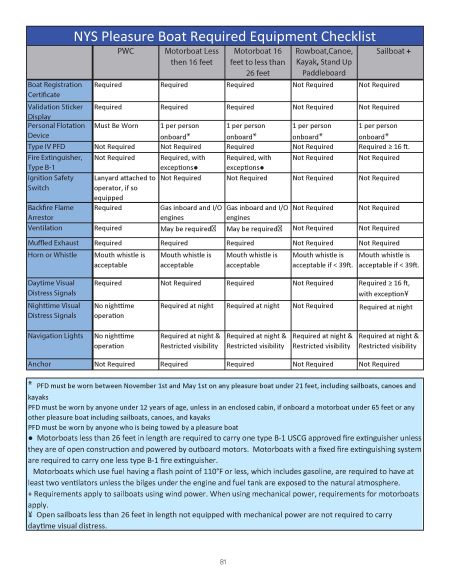Motorized Boats
Whether you are cruising across the Great Lakes, trolling in your fishing boat, or towing your grandkids on tubes, you are a motorized boater. All motorized boaters have the same responsibility to be safe and are subject to the same hazards on the water.
Fire Extinguishers - NEW REGULATIONS starting April 20, 2022
The United States Coast Guard has changed regulations regarding disposable fire extinguishers aboard motorized recreational boats. This federal law change applies on all New York waters.
- Disposable fire extinguishers are now considered expired 12 years after the manufacture date and must be replaced upon expiration. The manufacture date is either stamped on the bottom of the extinguisher or printed in a box on the label.
- Fire extinguisher labels are changing. A Type "5-B" and "10-B" fire extinguisher can replace the former "B-I" extinguisher. A Type "20-B" fire extinguisher can replace the former "B-II" extinguisher. Boats less than 26 feet in length and model year 2018 or newer must carry extinguishers bearing the new label effective April 20. Boats model year 2017 or later may continue to carry extinguishers with the old labels until they expire.

Life Jackets

The one piece of safety equipment that all boats must carry is the lifejacket. Studies show if you choose to wear a lifejacket and you fall overboard, it increases your chance of survival. During the period 2005 - 2021, 82% of all drowning victims did not wear a lifejacket. Hidden hazards in the water, inclement weather, and unpredictable currents can be a danger to you and your passengers and wearing your lifejacket helps protect you and your family in unexpected circumstances.
Please note that in New York State, lifejacket wear is required for all boaters under 12 years of age and for all recreational boaters (including paddle craft users) aboard a vessel less than 21 feet in length from November 1 - May 1 (cold water months).
Your lifejacket must be:
- US Coast Guard approved
- Easily reached in an emergency (readily accessible)
- Free of fading, rips, or tears
- The proper size for the intended wearer
Did you know that there are different types of lifejackets? There are many more comfortable and stylish lifejacket options than the bright orange ones you may be familiar with.

Required Safety Equipment
To ensure a safe voyage, all boats have certain equipment that must be carried, per the navigation law. Find out what you need to have aboard before heading out on the water.

- There are additional equipment carriage requirements. Click here for more information
https://www.nxtbook.com/nxtbooks/nysparks/ny_boatersguide_21/index.php#/p/28

- Looking for a hard copy of the New York State Boater's Guide? Click here to request your copy. https://forms.office.com/g/77QE7NihQt

Specialty Craft
Click the Personal Watercraft tab for information on specialty craft, such as motorized surfboards.
Planning Your Trip
Before you pack your bags and head out to sea, be certain to share your plans with a reliable and trusted person who will remain on land. The details of your voyage are often referred to as a float plan.
In your float plan, include where you are planning to go, who is going on the trip, vessel information, when you plan to depart and return, and who to contact in an emergency. Be sure your emergency contact knows where to find the details of your float plan. If you do not return when anticipated, your reliable, land loving person can notify emergency personnel.
A float plan can be as simple as a text message or more complex for extended trips. Consider using a template, such as this one , to make sure all the important information is recorded.
, to make sure all the important information is recorded.
You can search for a boat launch site at https://parks.ny.gov/boating/launch-sites.aspx
You can also download the FREE Parks Explorer App to find information about State Parks with marinas and boat launches https://parks.ny.gov/explorer-app/
Boating Accidents
You can prevent many accidents if you communicate with your passengers. Before you allow passengers on your boat, explain your rules. Before you cast off, show them where you keep your safety equipment, and make sure they know how to use it. Find out if any of your passengers have any knowledge of first aid procedures. Well informed and well-behaved passengers help ensure a safe voyage. Most accidents can be prevented by following good boating safety practices.
If you are involved in a boating accident, you are required to report it to New York State Parks within 5 days if the accident resulted in:
- An injury that required medical care beyond basic first aid
- Death or disappearance of a person
- Damage to any one party in excess of $1,000
Be an Environmentally Conscious Boater
Help stop the spread of Aquatic Invasive Species. Be sure to Clean, Drain and Dry your boat before launching it in a new body of water. Find a boat decontamination station here: NYS Public Boat Launches with Boat Stewards or Decontamination Services (arcgis.com)
Learn more about Aquatic Invasive Species here: Aquatic Invasive Species Boat Stewards - NYS Dept. of Environmental Conservation 
Protect the Critically Endangered North Atlantic Right Whale
With fewer than 350 individuals remaining, The North Atlantic right whale is one of the world's most endangered large whale species. To help reduce vessel strikes, most vessels 35 feet in length or larger must not exceed speeds of 10 knots when operating in seasonal speed zones. These speed zones run along the easter coast. Speed limit regulations are seasonal and in effect from November 1- May 30 in this region. For more information, please visit: https://www.fisheries.noaa.gov/ 
Hidden Danger: Carbon Monoxide
Carbon monoxide (CO) is a toxic gas that is colorless, odorless and tasteless. On boats, CO is emitted by engines, gas generators, cooking ranges and heaters. The build-up of CO inside boat cabins, partially enclosed cockpits, beneath swim platforms or other enclosed areas is potentially deadly. Symptoms of carbon monoxide poisoning are similar to the symptoms of sea sickness, which makes it dangerously easy to ignore. New York State strongly recommends the use of carbon monoxide detectors in enclosed areas of your boat to keep you and your passengers safe.

For more information on carbon monoxide and safe boating, visit:
